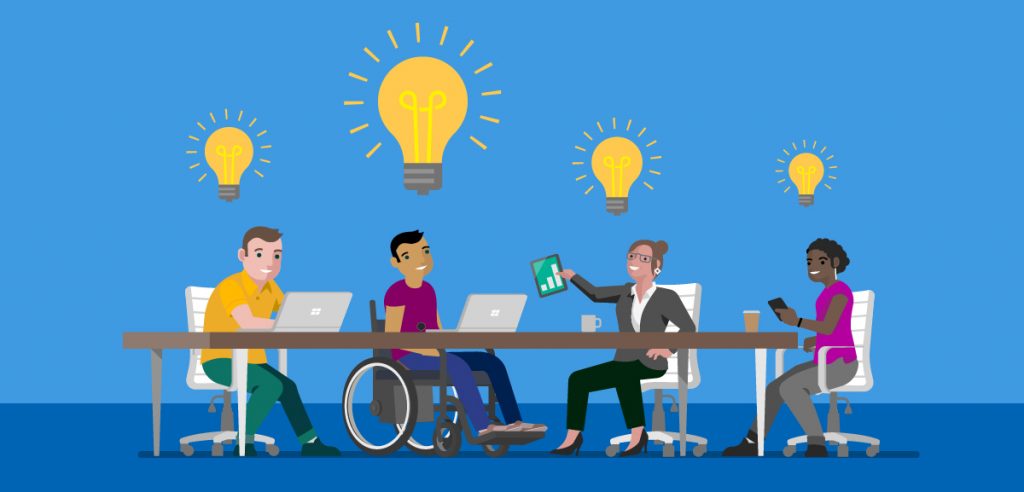
How a culture of inclusion stops companies from missing out
Both inside your company and outside, you’ve a large pool of talent to choose from. Handled right, they could help your business flourish. But are you making the most of this pool? We asked Kerri Hollis, who leads the UK Accessibility Practice from the Business Group, for her views on how you can create a culture of inclusion. She knows the benefits that people with disabilities can bring, and the strategies that can make a difference for them.
We keep hearing about the war for talent and how companies need to recruit and retain the best. But here’s a question that I keep asking myself. Why would a company want to limit the size of the talent pool that’s available to them?
This is exactly what more than half of workplaces are doing. It sounds almost unbelievable. But it’s absolutely true. They’re excluding people with disabilities. A couple of years ago, Acas reported that companies employed over three million people with disabilities, but that still left nearly five million without a job. The ridiculous thing is that this is completely unnecessary. It’s generally founded on misconceptions. And in fact, by excluding this pool of talent, they’re excluding some extraordinary performers.
Misconceptions like…
Many people still have preconceptions about disabilities. They believe that employing people with disabilities is going to cost more money. That it’s going to take up more resources or people will have more days off sick.
Wrong, wrong, and wrong.

To start with, any adjustments you need to make – and bear in mind that you may not need to make any – may be small or low-cost. For example, a designated parking space won’t cost a thing. Nor will giving someone a dedicated place to work instead of hot desking, or offering them a more flexible working pattern.
Don’t be embarrassed to ask what would make a difference to someone’s ability to do the job. It’s a question you’re already asking if you operate a choose your own device policy.
And remember, around 70% of people don’t have any visible sign of their disability. They could have diabetes or epilepsy, for instance.
So what can you do to create a workplace that’s truly diverse and welcoming? You create a culture of inclusion.
Why an inclusive culture is better
Having a culture of inclusion is about creating a place where everyone feels included and valued. And where gender, disability, and ethnic background aren’t relevant to people’s abilities to do their jobs. Helping people to be their best means that the business – and others – benefit as well. If you can enable everybody to achieve more, you’re not just empowering those with a disability. You’re helping everybody on the planet to do more.
Word spreads fast if you’ve got such a culture. You attract talent from everywhere. You also help your existing employees with disabilities – even those with hidden ones – to be happier and more productive. And why not? They’re getting a chance to shine.
Accessibility is ultimately a business imperative. A study by Accenture revealed that companies that embrace best practices for employing and supporting persons with disabilities in the workplace outperform their peers with:
- 28% higher revenue
- 2x higher net income
- 30% better performance on economic profit margin
Here’s something else that’s cool about an inclusive culture – your employees act as a bridge to your customers. A representative workforce is more likely to be able to understand customers and give them what they want and need.
Make everybody part of it
Developing this sort of culture isn’t done in a flash. You’ve got to help your organisation become disability-confident. Here are four tips to get you started:
- Your leadership team is a good place to start. Right from the top, you need to recognise that what the business really needs is a culture that includes different nationalities, ethnicity, genders, sexual orientations, and people with disabilities.
- Acknowledge the conscious or unconscious biases that exist in the business. It’s the only way to tackle them.
- Embrace difference. If you keep relying on the same people, you’ll get the same ideas and the same results. Bringing in fresh people means opening the door to new ideas and innovation.
- Give your team access to the tools that will help them excel.

Tech’s about expanding what people can do
Tech and accessibility features can make a big difference in an inclusive culture. The main thing to remember is that the devices in your business may already have the perfect tools built in so you should start by encouraging people to use these features:
- Voice-controlled software provides an easy way to navigate around the screen and use apps.
- Sticky keys cut out the need for people with mobility issues to use complex multiple key strokes.
- Speech tools turn speech into text or read out text.
- The Office 365 accessibility checker helps people prepare documents that work for everyone.
Call on everybody
Use your available accessibility tools to draw on the talent of people with disabilities – rather than miss out on this asset. But don’t stop there. The same tools could help all your employees find the best way of working. Success will come if focus dedicated attention on creating a culture of inclusion and keep your mind open to different ways of doing things. So think inclusive, act inclusive, design inclusive. You’ll be delighted by the results when everyone gets involved.
Find out more
3 ways modern tech can foster and inclusive culture
A practical guide to building a more accessible workplace
About the author
I have been at Microsoft for almost seven years and have worked across sales, partner, and now the Business Group. I often think about what I love most and quite simply it’s about making life easier for people – why should you need to check a hundred different places for information? Why should it not just be at your finger tips? That’s exactly why I lead the Microsoft UK Accessibility V-team. We’re responsible for empowering every individual on the planet to achieve more, regardless of physical or mental ability.




